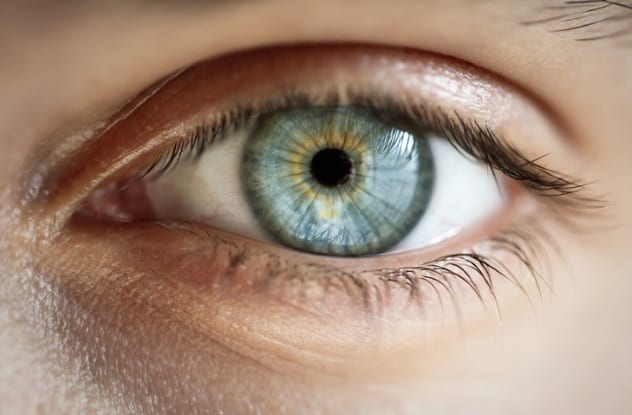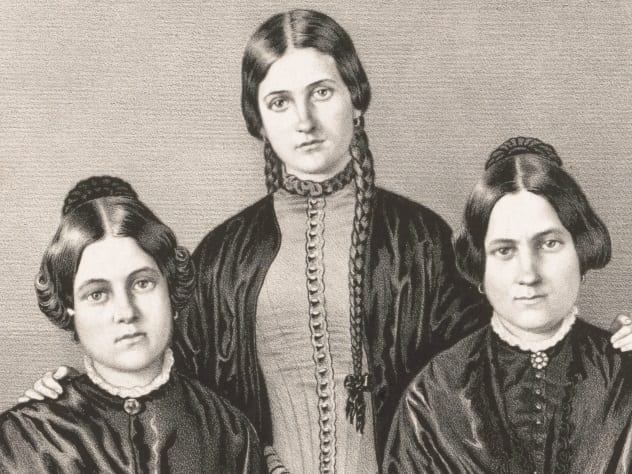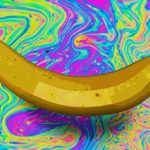Here is a list of pseudosciences (false scientific methods, theories, and systems) and hoaxes that fooled people all over the world. More than a few are still believed even today.
10 Canals On Mars
People have been fascinated with space and the mysteries of our solar system for centuries, and the planet Mars has been on our minds since people first took note of it in the night sky. In 1907, Mars rocketed into the mainstream news when The New York Times reported that there was life on it. Astronomer Percival Lowell reported that he had spotted a “canal system” on the Red Planet. Lowell hypothesized that this must mean that there was life on Mars when he said, “It is a direct sequitur from this that the planet is at present the abode of intelligent constructive life. I may say in this connection that the theory of such life on Mars was in no way an a priori hypothesis on my part, but deduced from the outcome of observation, and that my observations since have fully confirmed it. No other supposition is consonant with all the facts here.” If you’re surprised that you’ve never heard about this, that’s because it isn’t true. There are no canals on Mars. The entire debacle was contrived from a simple translation error. Decades earlier, another astronomer named Giovanni Schiaparelli actually reported “channels” on the surface of Mars, a sight that would be turn out to be an illusion. His report was mistranslated, as he originally wrote his observation in Italian as canali. When Lowell read of Schiaparelli’s findings, he, too, observed the planet, saw the same illusion, and the rest was history. This eventually led to the assumption that if there were canals, then there must also be Martians. Even Lowell’s obituary mentions that, “He detected 550 canals.”[1] This misconception was denounced by many astronomers, but that didn’t stop a select few “canal enthusiasts” from towing the theory until technology advanced enough for better pictures of Mars to be taken, proving once and for all that there were no canals on Mars
9 Phrenology
Just as humans have been intrigued by the mysteries of faraway worlds, we have also been captivated by the unknown that’s hiding in our own minds. Phrenology was a branch of psychology that became popular in the early 1800s. The theory was derived from the works of physician Franz Joseph Gall, which he called “cranioscopy.” He and his followers believed that the personality and intelligence of a person could be hypothesized by the shape of the person’s skull. The skull’s evenness and where there were bumps could relay how the “organ” that represented different traits such as benevolence developed.[2] In what would become a pattern for many of the defunct sciences of this list, Gall and his followers only sought evidence that would validate their beliefs. They discounted any evidence that contradicted, using assumptions and circumstantial reasoning. Phrenology would explode in several Western countries. It would be used to further racial prejudice by trying to prove that several races were lesser than others based on the shapes of their skulls. The movement would also become a fortune-telling-like craze, so much so that there is documentation of phrenology “character readings” being mandatory for employees so that their employers could ensure that they had the desired character traits. Fortunately, phrenology followers were unable to pass off their “knowledge” to the following generation, and the movement died out.
8 Iridology
Iridology is another medical pseudoscience from a century ago. Unfortunately, unlike phrenology, iridology hasn’t completely died out yet. A diagnosis system created by Ignatz von Peczely, iridology has since become an alternative medical practice that even has schools and programs that proclaim its effectiveness today. Peczely first came up with the idea as a young boy, when he nursed an owl with a broken leg back to health. He noticed that the owl had a black strip in its iris that was replaced with white stripes when it was fully healed. When Peczely was an adult, he published research on the subject. His hypothesis was that the iris connects to the rest of the body, so the colors inside the eye are an indicator of the body’s overall health. The theory is perfectly understandable, but Peczely did not conduct the appropriate research and testing to prove iridology as a valid study. All Peczely produced to confirm his theory were his elaborate and imaginative maps of the iris. The maps linked a section of the iris to a random area of the body with ailments that could be diagnosed using the iridology method. There was not and has never been any anatomical or physiological evidence to support their claims.[3] Practitioners of iridology diagnose vulnerable people with no further proof than the state of their eyes. This could easily lead to an incorrect diagnosis of very serious medical conditions that could put those vulnerable people in danger. The chance of an iridologist diagnosing the correct ailment is entirely random.
7 Spiritualism And The Fox Sisters
Spiritualism is a common belief system in modern times. Although specific beliefs vary, the main concept of spiritualism is the idea that a person’s soul can persist even after they have died. As one can assume, there is no evidence of this being true, but many people hold on to this belief as comfort. Spiritualism rose to popularity due to the cultural phenomenon of the Fox sisters. Leah (right above), Margaret (left above), and Kate (center above) Fox’s family lived in an old farmhouse in New York in 1848. At night, the family was said to have been tormented by “raps” (strange bumping noises) that the youngest sister, Kate, was said to have been able to communicate with using a code system to translate the sounds. They claimed that the noises were coming from the spirit of a man who had been murdered in the house. They named him Mister Splitfoot. This quickly launched the Fox sisters’ career. They began a traveling stage show as mediums who would contact the dead, albeit for a considerable fee. When they weren’t on the road, the sisters would hold seances. But even in their heyday, they had their skeptics. Multiple times, their skills were tested. Sometimes, the sisters would pass, and they’d be praised for their abilities. Other times, they’d be exposed and humiliated. The stress of their fame soon overcame them one by one. Heavy drinking, the deaths of several loved ones, and a final humiliating failure in front of an entire committee of skeptics finally lead to Maggie’s confession: It was all a scam. They had created those rapping noises by cracking their toes. They conducted the rest of their seances with cold readings and carnival tricks. Maggie, on stage at the New York Academy of Music, declared, “I have seen so much miserable deception. That is why I am willing to state that Spiritualism is a fraud of the worst description.”[4] Skeptics would cheer on the confession, and other spiritualists, many of whom had started their careers in the Fox sisters’ shadow, would denounce Maggie as a raving drunk. Kate and Maggie would succumb to alcoholism and become poor, while Leah, their still-wealthy former manager, would turn her back on them.
6 Homeopathy
If you’ve ever heard the phrase, “Fight fire with fire,” then you understand the basis of the homeopathic approach to medicine. A German physician named Samuel Christian Hahnemann devised the theory in the late 1700s, before most of the modern practices of medicine were established. Hahnemann developed symptoms similar to malaria after coming in contact with a piece of cinchona bark. Cinchona bark contains quinine, which is the drug used to treat malaria. This occurrence caused the elated physician to declare the first law of homeopathy: similia similibus curentur, or “likes are cured by likes.” This was the beginning of homeopathy and its many laws. In modern times, homeopathy is treating an illness with diluted doses of a substance that would cause the condition that you’re trying to cure. Homeopathy, whose roots are German, has an alarming history in its country of origin. Even the Nazis put an unsettling amount of effort into proving these theories, to disastrous results.[5] The process of finding what amount of a substance should be used is inconsistent, created first by Hahnemann and, despite the best of efforts of other scientists, unreproducible. The comparison between homeopathy and modern vaccines has been made in the practice’s defense, but the difference is that homeopathic remedies, which are usually drunk, are made of only the diluted substance. Vaccines, in layman’s terms, contain other proteins that are meant to not just match the illness it’s protecting against but also trigger the immune system to properly fight it. The comparison between the two medical practices is contrarious. Homeopathy is dangerous because its believers try to sway the ill and injured away from getting medical attention with quick-fix treatments that don’t work. It would be no better than taking any other placebo. Perhaps for less serious ailments, the patient will feel better, but serious conditions will go untreated and, in worse case scenarios, can lead to an otherwise preventable death.
5 Reflexology
Reflexology is quite like iridology but expanded to the entire body. Occasionally called zone therapy, reflexology asserts that the body has reflex areas that can promote healing when pressure is applied. A US physician named William Fitzgerald first created a chart of corresponding zones on the feet in 1913. Nearly two decades later, a nurse and physiotherapist named Eunice Ingham expanded upon Fitzgerald’s work and spread her ideas across the US. Reflexology would soon include the hands and the feet, instructing that they related to the central organs. It is acupuncture without the needles, and most practicing reflexologists say their methods will ease the most random issues. Proper stimulation can apparently deal with a number of issues effortlessly, such as weight loss, kidney stones, bed-wetting, cataracts, deafness, heart disease, and too many other applications to count. Every illness is apparently derived from “stress,” which only they can ease for you.[6] In reality, reflexology is just a glorified hand and foot massage. An appointment could be pleasant, but it will never be a cure-all.
4 Ancient Astronaut Theories
Ancient astronauts, otherwise known as ancient aliens, are properly classified as a pseudoarchaeology. We commonly hear these types of conspiracy theories noways in a variety of contexts. Aliens apparently arrived on Earth at some point in the past, leaving evidence of their visit behind because of how they shaped human cultures and the environment. They built the pyramids, they built Stonehenge, they left crop circles, and so on. Other apparent evidence is how different ancient religions have myths about alien-like creatures and gods. Also, there are artworks that depict nonhuman figures and architecture deemed too “futuristic” to have been created by humans at that point in history. So why do these conspiracy theories exist? Well, the idea first teased our minds in the wake of science fiction stories popularized in the late 19th century. Desperate to make some semblance of these fantastical stories true, many people tried to gather evidence to prove their conspiracy theory to the world. One of the first of these people was Erich von Daniken and his book Chariots of the Gods? Unsolved Mysteries of the Past, published in 1968. His assertions that extraterrestrials built ancient structures for us was the first of its kind, and the theory quickly spread. Other, similar works would pop up for decades afterward, with similar arguments in favor of ancient aliens. One would think such musings, based on the naive want for science fiction to be fact, would be harmless fun. Unfortunately, the pursuit of evidence has led to several instances of vandalism and theft at sites that are believed to be made by these aliens. It’s also rather concerning that the architecture that is being targeted as evidence comes from cultures in Egypt, Africa, and the Americas that have commonly been the targets of prejudice by other cultures. The assumption that these cultures weren’t “smart” enough to accomplish such technological feats can be rather insulting to its people. It also subconsciously reflects the same racist bigotry as colonists who treated those people as less intelligent and, as such, in need of their guidance to “civilize” them.[7]
3 Conversion Therapy
The medical and therapeutic pseudosciences previously discussed have all championed cures for legitimate illnesses and medical conditions. Conversion therapy uses bogus and barbaric treatments to cure what was never a disorder in the first place. It all started when a German psychiatrist Albert von Schrenck-Notzing made the bold claim that, through hypnotism, he had turned a gay man straight.[8] This would snowball into more and more psychiatrists and doctors targeting LGBT people with theories and experiments in ill-intentioned attempts to fix them. Aversion therapy would try to negatively associate same-sex attraction through induced vomiting and electric shocks while being shown pornography. The even less fortunate were lobotomized or received shocks directly to their brains. One historian, Elise Chenier, said on the experiments, “Although proponents of aversion therapy claimed ‘cure’ rates of as high as 50%, these claims were never satisfactorily documented. Often patients were rendered asexual in response to aversion therapy; these were counted among the successful treatments. [ . . . ] It has been documented that some homosexual men who underwent aversion therapy have suffered serious long-term psychological effects, including depression, despair, and attempted suicide.” Occasionally, there were even people who, convinced that a harmless part of themselves was immoral, would seek out the therapy. These people often claimed it cured them when they were only shamed into acting out the role of what a heterosexual person should be. Conversion therapy, in reality, is a placebo to ease the fear and hatred of homophobic people at the expense of a vulnerable minority.
2 Astrology
Of all the pseudosciences and hoaxes in this list, astrology is probably one of the most harmless. By using constellations and other heavenly bodies such as the Sun and Moon, astrology tries to predict future events based on their positions and movements. There are three different subsections of astrology. Mundane astrology tries to predict generalized world events, and interrogatory astrology tries to predict specific events within a specific person’s life. Natal astrology is the astrology that most people think of first. It uses horoscopes based on a person’s date of birth and corresponding zodiac sign to give advice on things such as interpersonal relationships and career pursuits. Believers always have one instance where an astrological prediction was correct. But, if one really thinks about any of these predictions, their open-ended nature becomes obvious. The ability to interpret any answer as correct makes astrology untestable, and if you cannot test a science, then you cannot modify it. Every evidence-based science has included incorrect theories that, over time, were phased out when proven to be false.[9]
1 Vaccine Hesitancy
And finally, the most provocative pseudoscientific fad to wreak havoc in recent memory. Currently, there has been a worrying trend of people, parents in particular, who have refused medical vaccinations for themselves and their children. The fear seems like a recent phenomenon, but the hesitancy surrounding new medicine has existed for a long time. People are superstitious and nervous around the new and unknown. Vaccines are a relatively recent scientific breakthrough. The first laws that made any type of vaccine mandatory were billed in Europe and Boston within 25 years after the first smallpox vaccine was created by Edward Jenner in 1796. As more vaccines were developed, smallpox and otherwise, more laws were put in place. All of this would improve the health and herd immunity of the developed world until the life expectancy of the average person would increase from 40 to 80 in a few hundred years. There has always been hesitancy over vaccines, but international attention has zeroed in on a recent increase in “anti-vaxx” believers, as the belief system has gone from general nervousness to a red-pill philosophy. The reasons vary. Some think certain vaccines are a cause for disorders such as autism, based on a widely debunked report by disgraced pseudoscientist Andrew Wakefield. Other reasons include the belief that vaccines have unethical or poisonous ingredients like mercury or discarded fetuses from abortions. This is untrue. The assumption that a chemical you aren’t familiar with is immediately poison is ludicrous, especially if you know next to nothing about chemistry. Some people think vaccines are unnecessary and that natural remedies like oils and a good diet are enough to cure and stave off diseases like polio and measles. While healthy life choices are important, they are not a substitute for vaccinations. If they were, then the life expectancy of people before vaccines wouldn’t be so low. Other skeptics don’t believe that vaccines are harmful but do believe that they are useless and only advised by doctors for profit. The evils of “Big Pharma” are present in other conspiracy theories, such as mental illness skepticism. While prices for medical treatment can be inflated, in the US in particular, competition in the market is usually regulated. Beyond that, several of these vaccines aim to stop the disease completely. If they only operated for the profit, then they would produce medicine that only partly cured the disease and necessitated constant medical intervention to rack up the bill over the patient’s lifetime. The prices are cost-effective for the research and development of these vaccines. The cost to vaccinate before the disease is also much lower than the cost to treat such illnesses after they are contracted.[10] When we subscribe to a set of beliefs, we will seek out confirmation before contradiction. If enough people validate us, we think that’s enough to reject all opposing word. But that is not the way science and knowledge should develop. We need to constantly reevaluate what is and isn’t true to weed out the false and ill-conceived. It may be hard to tell the reputable sources from the conspiracy theories at first glance, but that is exactly why, in pursuit of what is best for ourselves and society, we need to be more attentive. We need to be aware of our inherent biases and never put the preservation of our ego above evidence and fact when we are proven wrong. Savannah O. Skinner is a freelance writer and author, with published fiction under the pen-name S.O. Skinner.
























